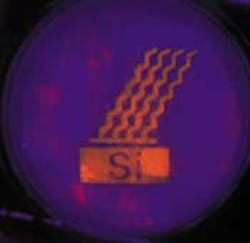Team harnesses light-emitting properties of porous silicon

Purdue University (West Lafayette, IN) researchers have developed a method to harness the photoemissive properties of porous silicon and use them to stabilize the material's surface. The procedure can be used for applications in optoelectronics or integrating light-emitting devices with silicon chips, according to Jillian Buriak, an associate professor of chemistry. The development is expected to allow scientists to tap the photoemissive qualities of porous silicon to create new types of drug delivery systems, or biological and chemical sensors capable of performing real-time measurements in medicine and manufacturing.
"We've shown that we can tailor the surface of a porous silicon wafer to survive within simulated in vivo conditions such as those found in blood plasma," said Buriak. "Untreated porous silicon dissolves too quickly to be useful in these environments. By treating the surface, we may be able to develop sensors for use in diagnosing and treating disease."
The research team was able to detail the chain of events that occurs when light photons interact with nanocrystalline silicon, which causes electrons to jump to a higher energy level. Energy is emitted in the form of light as the particles move back to their former state. In the process of moving to a higher energy level, the electrons leave a positively charged hole where a second electron might react, creating excitons. Using white light of moderate intensity (~20 mW cm-2) from a tungsten source, the researchers created excitons in the laboratory by exposing wafers made of nanocrystalline silicon to the light for 30 to 60 min. in the presence of alkenes or alkynes (chemical compounds that contain hydrogen and carbon).
An additional benefit of the reaction is that by using a mask between the porous silicon and the light, the reaction can be photopatterned because it only takes place where the surface is illuminated. This step allowed the researchers to tailor the material in specific areas, directing the light-emitting properties of porous silicon to respond with the chemicals where it was required (see figure).
REFERENCE
- M. P. Stewart et al., J. Amer. Chem. Soc. 123, 7821 (July 2, 2001).
About the Author
Sally Cole Johnson
Editor in Chief
Sally Cole Johnson, Laser Focus World’s editor in chief, is a science and technology journalist who specializes in physics and semiconductors.
